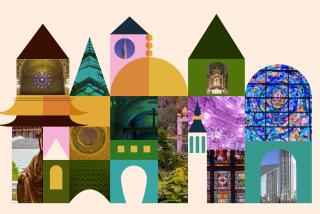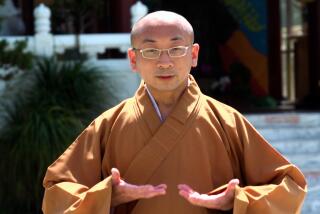Rare Tibetan Buddhist Sculpture Consecrated as a Tool for Peace
In a 1,300-year-old ceremony of chants, incense and clanging cymbals, a rare and sacred Tibetan Buddhist sculpture was formally consecrated in Glendale on Saturday and offered as a blessing for universal peace.
“With so much violence in the world, we cannot stay as silent spectators,” said Lama Chodak Gyatso Nubpa, who sponsored the project with his Los Feliz Buddhist center. “Whatever benefit we can bring, we must do our part to bring.”
Tibetan Buddhists believe that the bejeweled icon of intricate art and intense spirituality can transform negative emotions into compassion and altruism. It is the first three-dimensional mandala--a circular design representing a map to enlightenment--ever built in the United States.
Along with its peace blessings, the mandala project represents an urgent race to preserve Tibet’s vanishing cultural and religious art heritage.
Once a standard fixture in most large Tibetan monasteries, the mandalas have been all but wiped out amid the destruction of more than 6,000 monasteries under five decades of Chinese Communist rule. The effort to build one here took 11 months, $250,000 and supporters ranging from high lamas to such Hollywood celebrities as Stephen Stills and Sharon Stone.
The completed work, representing a celestial palace filled with 100 wrathful and peaceful deities, is known as the Shi-Tro mandala. It will be on display for three months at Forest Lawn Memorial-Park in Glendale before moving to the Pacific Asia Museum in Pasadena.
After that, Gyatso hopes to take the mandala around the nation, along with a curriculum in peace education for schools and community groups.
The icon, based on a 7th century blueprint, was built by a team of artists led by Pema Namdol Thaye. The 33-year-old artist is one of the few Tibetans left in the world with the artistic skills and deep knowledge of esoteric Buddhism required to build the mandala.
The soft-spoken Thaye, who meditates before work each day to remove his own impurities, said that each of the hundreds of elements of the mandala is dense with spiritual meaning.
As one example, he pointed to a figure of one Buddhist deity embracing his consort. Thaye explained that it symbolized the union of female wisdom and male capability; his sword represented cutting through ignorance, while his garland of skulls signified the conquering of the “three poisons” of ignorance, desire and hatred.
But the mandala, sponsored by the Chagdud Gonpa T’hondup Ling center, seemed to move even those unfamiliar with its intricate meanings.
“The sheer beauty of it appears to carry the artist’s intention, which is to release the vibrations of peace,” said the Rev. Michael Beckwith of the Agape International Center of Truth in Culver City. “When someone spends so much time in prayerful intention, the work becomes both artistry and ministry.”
Others, however, seemed perplexed. “It’s mystifying--there are so many deities and no explanation,” said Barry Keehn, executive director of the Japan-America Society. “You find yourself pondering the philosophy.”
The three-hour consecration ceremony at Forest Lawn featured both ancient Tibetan rituals and interfaith blessings from Christian and Jewish clergy. Before flickering candles and hundreds of offerings of flowers, liquid and sweets, the Most Venerable Gonjang Rinpoche of India led the ceremony that Tibetan Buddhists believe brings down sacred energy of the deities to empower the mandala.
Once that energy is sealed within, the mandala is able to instantly liberate all who come into contact with it from the consequences of their harmful actions, or negative karma, Lama Gyatso said.
After the Tibetan ritual, Protestant minister Ron Beans and Catholic priest James Cavanaugh blessed the mandala with terms more familiar to non-Buddhists.
Beans read the Sermon on the Mount, while Cavanaugh blessed the mandala “as a symbol of religious devotion, which leads us to the path of nonviolence and universal peace.”
For Gyatso, whose team has worked around the clock in the last five weeks to complete the project, the mandala’s blessing is clear:
“For people to try to recognize their own kindness, nurture it, treasure it and widen that quality,” he said.
More to Read
The biggest entertainment stories
Get our big stories about Hollywood, film, television, music, arts, culture and more right in your inbox as soon as they publish.
You may occasionally receive promotional content from the Los Angeles Times.











